
Calm your nerves and focus on educating
Automate educational processes

Modern-day technologies are actively changing the way automation in education takes place. Indeed, the artificial intelligence (AI) and Robotic Process Automation (RPA) market in the US education sector is expected to reach nearly $85 million by 2022. We see more and more organizations investing in digital adoption and cutting-edge automation technologies to achieve business automation success.
Still, the actual role of automation in education and in students’ day-to-day lives leaves much to be desired. Surrounded by gadgets, students predominantly use them for communication and entertainment. At the same time, the educational system itself remains stubbornly resistant to transformation. For most schools, the approach to teaching is still one-size-fits-all. At the end of the day, it’s the same old classroom with a single teacher teaching a group of about 30 students.
This level of uncertainty raises a bunch of questions:
Let’s try answering these and other questions by looking at some potential concerns and benefits that go along with implementing automation in education.
The number one reason that automation in education lagging behind other industries has to do with the lack of knowledge and expertise on how RPA operates. That’s why it’s absolutely crucial to provide both teachers and school administration with in-depth training on the concepts of RPA.
If you think about it, there’s nothing unusual about new technologies slowly but persistently making their way into our daily lives. In fact, that has been the trend for many world-changing inventions including airplanes, umbrellas, and even light bulbs. All of which endured plenty of public ridicule before becoming wildly popular.
When speaking about education, there are electronic calculators, computers, slide projectors, “smart” boards and other amazing stuff that wasn’t there even a couple of decades ago.
The same can be expected of automation. Schools, colleges, and universities can reap long-term benefits by adopting RPA and AI. This can be the disruption needed to stimulate change in education.
Deciding to pass up these technologies is no longer an option as any educational institutions opting not to implement RPA and AI will most likely find themselves utterly obsolete in just a year or two.
As a teacher or school administrator, you are probably wondering how exactly special education automated software works.
Just to clarify: by saying ‘robotic process automation,’ we don’t mean androids replacing teachers in the classroom. In fact, automation does not replace a process. Rather, automation complements a process.
In simple words, RPA is yet another way to build an effective working process using algorithms and software robots (Bots) capable of performing tasks without human intervention:
Every digital device in the world uses algorithms to some extent. In the case of special education automated software, an algorithm is a set of precise commands telling a device how to perform a task or process data.
Academic administrations often find themselves overwhelmed with repetitive, time-consuming tasks. Managing class schedules, keeping track of student attendance, processing grades, admitting new students — all these processes are as dull as they are valuable.
In this case, education automation is the ONLY way to keep administrative processes running, allowing the people in charge of these processes to save insane amounts of time.
By deploying an automated school document management solution, much of the manual paperwork routines can be completely eliminated. In the long run, this means that academic staff will be able to fill roles that empower them to be more inventive and creative. As a result, they’ll be able to focus on what matters in education: developing closer, more meaningful relationships with teachers, students, and parents.

Calm your nerves and focus on educating
Automate educational processes
On the subject of how automation will affect teaching jobs, there are concerns about whether RPA and AI technologies will result in unemployment. What are the chances of a teacher being replaced by a robot?
We have reason to believe this is highly unlikely. Additionally, teaching is considered one of the least vulnerable occupations when it comes to automation. According to the 2019 Brookings research, only 27 percent of the current tasks required in “educational services” are capable of being automated using existing technologies.
Instead of being replaced, teachers will use special education automation software for scheduling, keeping track of attendance and even grading. Automating these tasks will shift the responsibilities of teachers and allow them to spend less time on routine tasks and more time with their students.
As discussed above, automation in education delivers increased time-liberation and productivity. It also allows students to ease interactions with academic staff by receiving quality feedback on their homework, projects and exams, more quickly and accurately than ever before.
By adopting automation techniques, students will no longer have to deal with mistakes in grading or having to wait weeks to get feedback on their work.
Accordingly, schools and universities must de-emphasize role skills and use automation techniques to teach their students how to work better with machines — by doing what machines can’t. This means putting more focus on developing students’ digital skills, as well as an increased emphasis on experiential learning.
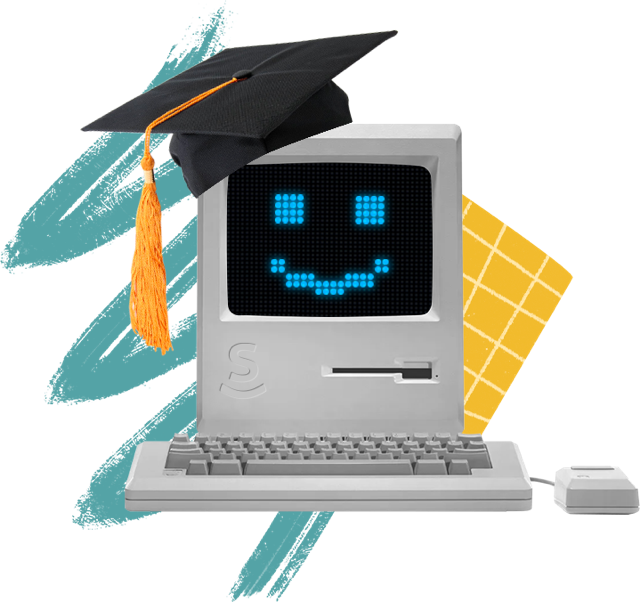
Education automation tools can be helpful for younger students and their parents in a range of ways. Primary and secondary schools can use it to increase student safety by sending an automatic SMS alert to a parent’s phone when their child unexpectedly misses school.
Enrollment processes. Student enrollment is one of the most time-consuming processes that educational institutions deal with. It usually comprises a whole bunch of paper-driven tasks that, if performed manually, are increasingly vulnerable to human error. Approving student application forms, validating documents, and manually confirming student eligibility for a given course is tiresome. Automated school processes are the best way for educational institutions to relieve this burden on their staff while collecting accurately completed forms, documents, applications, and affidavits from students remotely. airSlate’s out-of-the-box RPA solution with easily-configurable Bots that act automatically according to simple if-then logic manage the entire process. This allows faculty the time to validate documents, evaluate the eligibility of the criteria, and decide whether a student should be enrolled or not.
Meetup schedules. Planning and preparing for meetings is critical when it comes to organizing educational processes. Usually, an organizer checks the availability of attendees before scheduling a meeting accordingly. They then notify every attendee separately, passing on information for the date, time, and location of the meeting. Any time there’s a change, the organizer has to repeat the entire procedure all over again. However, with an automation education RPA solution, the entire scheduling process can be completely automated so that human involvement is minimized. All the organizer needs to do is set up a simple workflow that would check every attendee’s schedule and notify the participants.
Attendance tracking is another routine yet mandatory process that most educational institutions have to perform on a daily basis. And if you think that attendance only concerns students, then you are highly mistaken. It’s equally important to keep accurate records of faculties and school administration in order to ensure fair compensation for every team member. By adopting the special education automated software for your daily attendance tracking, you can, for instance, collect information for your employees’ working log. This approach allows for more fair evaluation and allows every employee to get the right compensation according to the presence within an institution’s routine processes.
Progress reports. In addition to managing exams, most teachers are required to fill out progress reports of every student in their class. Needless to say, that’s a lot of dull work to stay on top of. Automation can be a great help here. Once student grades have been stored electronically, you can use special education automated software to extract necessary data from the spreadsheet. You can also pre-fill progress cards and even send the progress report to those interested (e.g., parents). By doing so, you’re not only getting rid of this tedious job, but freeing up hours worth of daily time that can now be rededicated to other productive work.
airSlate can be used by any college, university, or school to automate and digitize academic processes of any complexity. With airSlate, it’s possible to take paper, confusion, and mistakes out of the equation and replace them with fast and simple forms for collecting more accurate data and saving time.
Watch the video below to learn how airSlate’s workflow automation can help your educational organization:
The NewSchool of Architecture & Design is a globally recognized and awarded design university. NewSchool’s vision is to be a leading provider of architecture, design, and construction management education. The university is focused on improving the quality of life in the built and natural environments on both the local and global scales as informed by nature, supported by research, focused on professional practice, and committed to sustainability.
However, because of their traditional methods for processing student applications, the university was experiencing a number of complications. One issue was the persistent buildup of hundreds of paper forms. That meant having to hire a part-time employee whose sole responsibility was to scan and file documents.
The biggest challenge came from students not completing forms with the necessary information before turning them in.
With the help of the airSlate team, NewSchool was able to determine the business needs of each form and figure out the best way to implement those needs. Mutchler recalls,
NewSchool students now enjoy a simpler way to access the forms they need and the Registrar’s Office has the ability to track at what stage each form is during its completion and easily store them afterwards.
With airSlate, NewSchool was able to set automated routing and roles directly into their forms so that they are forwarded to the correct department for approval and then back to the Registrar’s Office as an email that goes directly into their Customer Management System. This eliminated any need for having to scan files and upload them into the system manually.
The feature that NewSchool uses the most is conditional routing or the Send Slate with Roles Bot.
IATDE (in at the deep end) provides affordable and effective first aid and swimming solutions to the North East of England. IATDE’s custom and generic courses are flexible to suit your individual requirements. IATDE staff knows the education and voluntary sectors inside out, as well as the constraints being put on them at all times.
IATDE prides itself on being dynamic and forward-thinking while retaining its small family-like feel.
IATDE is adapting and modifying their teaching techniques to cater to all different learning styles and abilities. One of the swimming courses launched by the company is Autism Swim. And while the required information should be collected, it does take a lot of time to fill out.
Previously, the procedure of applying for the course would go as follows:
For someone to sign up for a class or to be an instructor, they would need to send an email asking for the necessary forms, print and fill them out, and then send them back accordingly.
However, very often, documents tended to get lost, so the applicants had to fill in all the documents and forms manually and send them back later. Delays like that caused clients to lose interest in IATDE.
Step 1.
In order to take classes, the applicants have to fill out two forms: the Enrollment and Referral forms.
The participants fill out the Enrollment form with their personal and contact information.
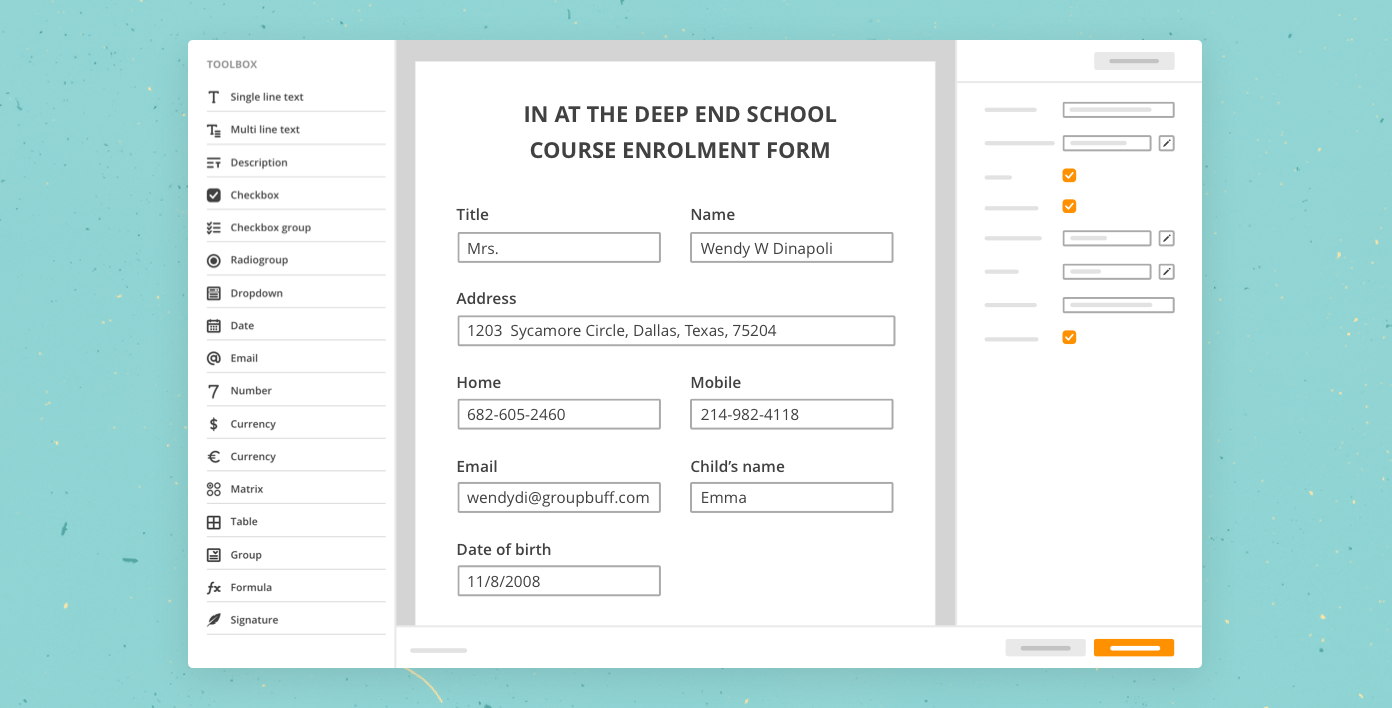
Step 2.
The participant’s data is then automatically pre-filled in the next document (Referral form). Here the Pre-fill from Doc to Doc Bot populates documents with data taken from another document. Data from the selected document will automatically be copied to the respective fields of the other document.
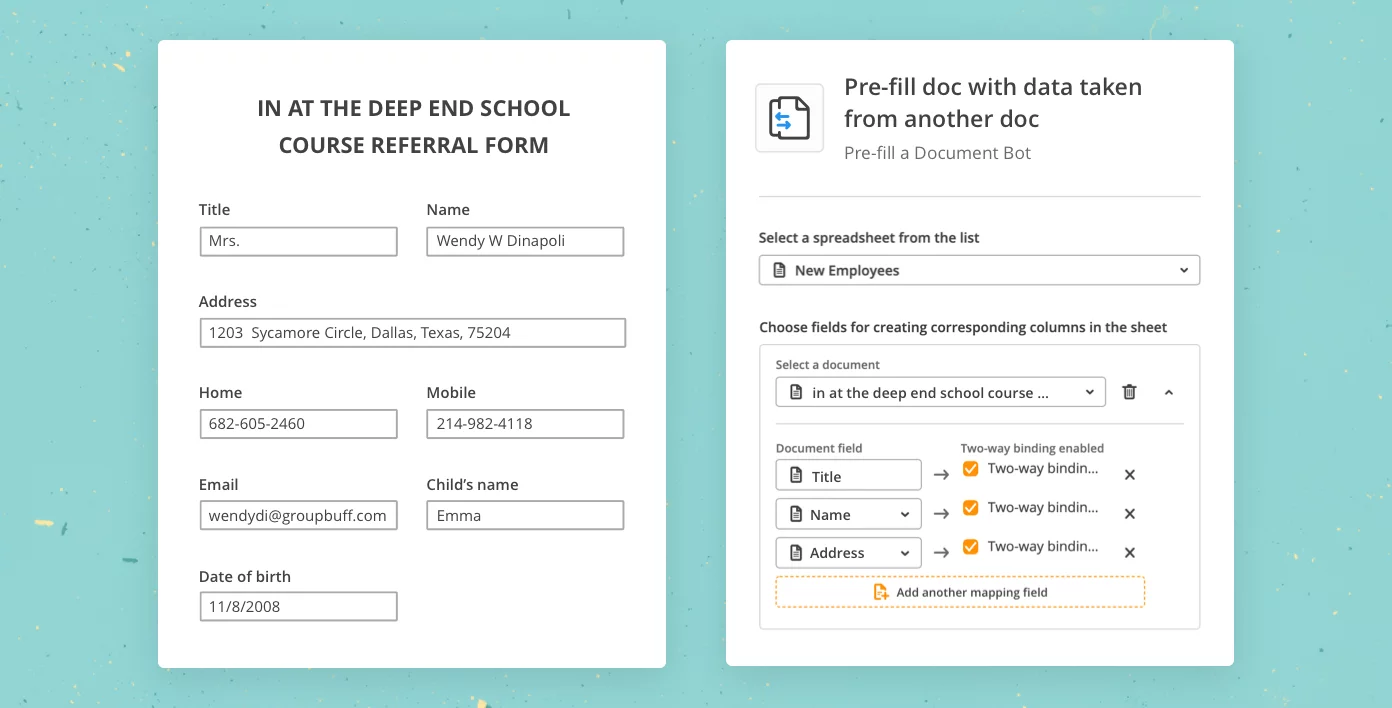
Step 3.
After both forms have been completed, the administrator receives an email. Then, any completed documents or forms cannot be skipped or lost. The Notify via Gmail upon Slate Completion Bot sends automatic notifications when a Slate has been completed.
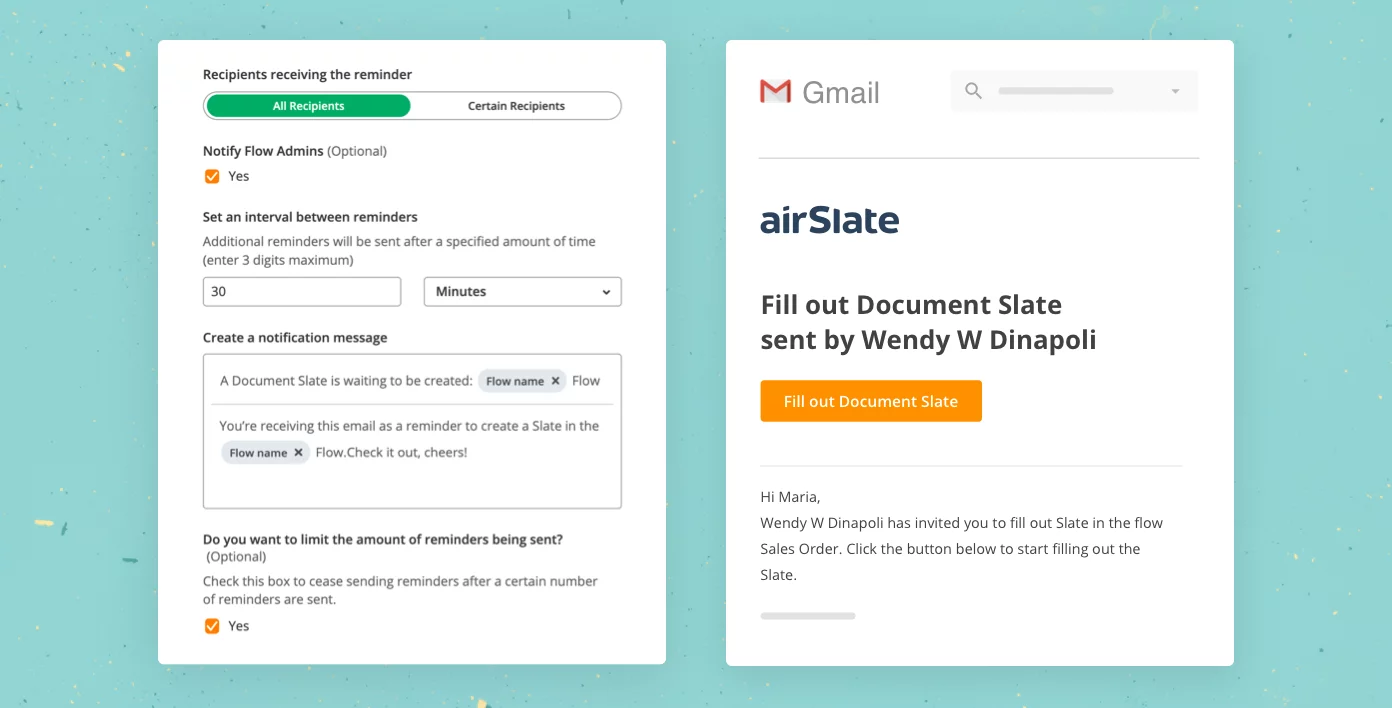
Step 4.
The completed Slates are saved to Dropbox in a folder named by/after the person who filled them out (e.g., Daisy Thorne). The Dropbox Bot then exports completed Slates to the designated Dropbox account.
After completing the Revision, two forms are successfully saved to this new folder and are available at any time.
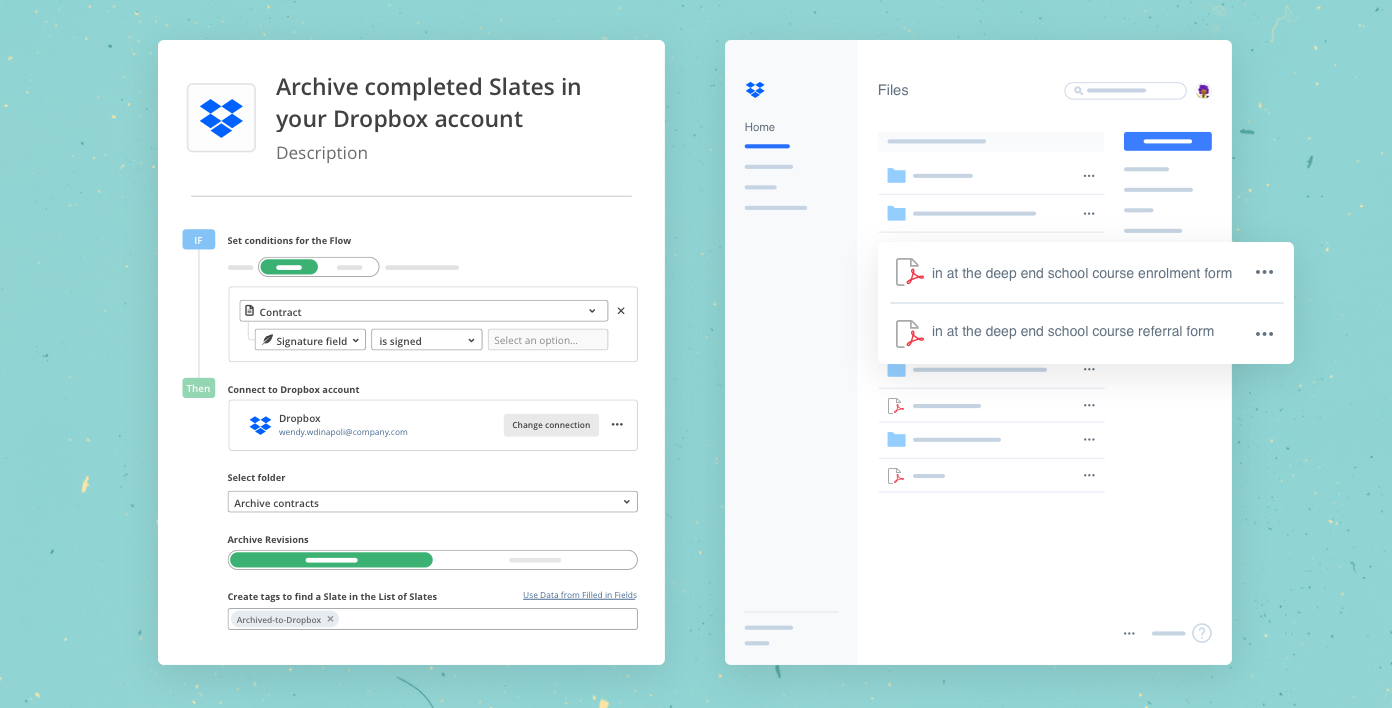
As a result, IATDE has eliminated unnecessary paperwork, saving both time and money. They have streamlined the process of registration, allowing teachers to focus more time on teaching children how to swim while student-teachers can receive better training.
Learn how to digitize and automate the school processes through the example of the student registration process, which takes paper, confusion, and mistakes out of the equation and replaces them with fast, simple forms, greater accuracy, and time saved. Complete the Student Registration Automation Course from our airSlate Academy for free.
The most significant value-adding boost that automation in schools will bring to the table is the additional interaction time that it gives to students and those who educate them. Automation will enable schools to adapt to student needs and provide more individualized teaching, allowing students of different skill levels to work together in the same classroom.
With technology that’s constantly monitoring student progress and patterns of learning, automation will be able to help teachers identify and address gaps in their teaching. In addition to grading fill-in-the-blank and multiple-choice assessments, education automation will help teachers quickly evaluate short-answer questions and essays.
This list could go on and on. While most of these benefits have yet to be implemented, there’s one thing we know for sure: with humans out of data-entry, educational processes can be streamlined and modernized while requiring far less time and effort to finalize.
Not all innovations are equally useful for achieving your goals. That, however, is not a reason to be skeptical. Automation does not necessarily involve complicated math or algorithms. In fact, deploying and administering workflows can be smooth, fun and… free!
With educational platforms like the airSlate Academy, you will learn how to build efficient working processes and design workflow to automate the school processes of any complexity. You’ll understand workflow analytics that can help you evaluate the efficiency of your current workflows and ones that you’ve recently automated. Plus, you’ll get hands-on experience with a cutting edge, no-code automation solution.
The automation journey will not come without challenges for both administrators and teachers. Though, that doesn’t mean that academic administrators won’t be able to reap the benefits of automation once implemented.
Learning automation is what will help you streamline your educational processes in the future.
Learn, transform and adapt to new models today!